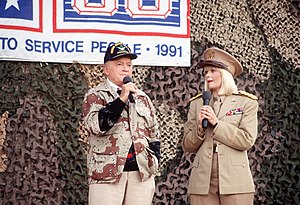 |
| This is my generations conflict. |
This is all stuff I took off the websites and condensed it to make sense: The photos are mine.
Armed Forces Entertainment (AFE) is the official United States Department of Defense (DoD) agency for providing entertainment to U.S. military personnel overseas.Armed Forces Entertainment hosts over 1,200 shows around the world each year, reaching over 500,000 personnel at 355 military installations.Types of talent include musicians, comedians, cheerleaders, and celebrities of sports, movies and television.
 |
| USO and AFE same goal different company |
Armed Forces Entertainment is an Air Force command operation and is the single point of contact with the DoD for providing entertainment to US military personnel serving overseas. It is the lead agency in providing transportation and logistical support for the USO in bringing celebrity entertainers to troops.
.
 |
| Armed Forces Entertainment typically showcases emerging artists but also features celebrity acts such as Kid Rock and Drew Carey |
- World War II-1951: The United Service Organizations (USO) Camp Shows program recruited and fielded live entertainment for military personnel. Camp Shows usually consisted of well-known celebrities who were recruited to entertain military personnel serving overseas. For many entertainers, this was their first time performing and traveling abroad. However, the Camp Shows scheduling, which was coordinated by each Service, was considered inconsistent.

 |
| Click to read side |
- 1951-1970: Before the establishment of the Department of Defense (DoD) in 1951, the Military Services agreed to provide a single point of contact for the USO. The Secretary of the Army was designated as the administrative agent for the DoD's relationship with the USO. Operational responsibility rested with the Adjutant General, then transferred to the Commander, U.S. Army Community and Family Support Center. In 1951, Service representatives were assigned to the new Armed Forces Professional Entertainment Office (AFPEO) to administer the fielding of USO Shows, provide shows where the USO Camp Shows were unavailable, and establish a regularly scheduled program.
- Units consisted of celebrities, professional artists, college groups sponsored by the American Theater Association (ATA) and the All American Collegiate Talent Showcase (ACTS). The USO and DoD sent thousands of entertainers, celebrity and non-celebrity, to entertain U.S. military personnel, DoD and Department of State civilians, and their family members worldwide. By the end of the Vietnam era, virtually all of the programmed shows were non-celebrity with DoD fielding over half of the units.
 |
| Click to enlarge photo and read |
- 1982: The USO cancelled the non-celebrity program to concentrate on the recruitment and fielding of well-known celebrity entertainment. The DoD directed the Secretary of the Army to assume responsibility for the non-celebrity program. In June, all non-celebrity entertainment units sent abroad were participating in the Armed Forces Professional Entertainment Program overseas, nicknamed "DoD Overseas Shows". In addition to the non-celebrity program, the AFPEO continued to uphold DoD's portion of the celebrity show responsibilities with the USO. These shows were renamed "USO/DoD Celebrity Shows."
- 1989: The Assistant Secretary of Defense (Personnel and Readiness) assumed operational control of the AFPEO with the Secretary of the Army remaining the Executive Agent. This assumption was designed to elevate the AFPEO's authority, facilitate coordination, and increase program visibility.
- 1997: The U.S. Air Force was assigned the Executive Agent for providing celebrity and non-celebrity programs to troops serving overseas, creating the jointly-manned office, Armed Forces Entertainment.
2008: First year of the Coaches Tour where college football coaches would visit the U.S. troops in the Middle East to provide entertainment relief.























































